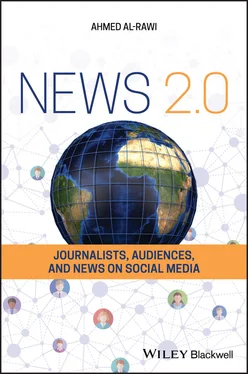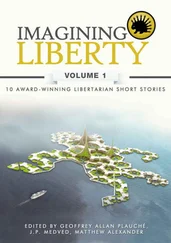34 Ju, A., Jeong, S.H., and Chyi, H.I. (2013). Will social media save newspapers? Examining the effectiveness of Facebook and Twitter as news platforms. Journalism Practice 8 (1): 1–17.
35 Kümpel, A.S., Karnowski, V., and Keyling, T. (2015). News sharing in social media: a review of current research on news sharing users, content, and networks. Social Media+ Society https://doi.org/10.1177/2056305115610141.
36 Kuo, L. (2018). World's first AI news anchor unveiled in China. Guardian. Available from: https://www.theguardian.com/world/2018/nov/09/worlds‐first‐ai‐news‐anchor‐unveiled‐in‐china(accessed November 28, 2019).
37 Lee, A.M., Lewis, S.C., and Powers, M. (2014). Audience clicks and news placement: a study of time‐lagged influence in online journalism. Communication Research 41 (4): 505–530.
38 Levin, S. (2018) “They don't care”: Facebook fact‐checking in disarray as journalists push to cut ties. Guardian. Available from: https://www.theguardian.com/technology/2018/dec/13/they‐dont‐care‐facebook‐fact‐checking‐in‐disarray‐as‐journalists‐push‐to‐cut‐ties(accessed November 28, 2019).
39 Lichterman, J. (2015). Snapchat wants to slip a little news into teens' social smartphone time. NiemanLab. Available from: https://www.niemanlab.org/2015/09/snapchat‐wants‐to‐slip‐a‐little‐news‐into‐teens‐social‐smartphone‐time(accessed November 28, 2019).
40 Lievrouw, L. (2001). New media and the “pluralisation of life‐worlds”. New Media and Society 3: 7–28.
41 Livingstone, S. (2003). On the challenges of cross‐national comparative media research. European Journal of Communication 18 (4): 477–500.
42 MacGregor, P. (2007). Tracking the online audience: metric data start a subtle revolution. Journalism Studies 8 (2): 280–298.
43 May, A. (2010). Who tube? How YouTube's news and politics space is going mainstream. International Journal of Press/Politics 15 (4): 499–511.
44 McCluskey, M. and Hmielowski, J. (2012). Opinion expression during social conflict. Journalism 13 (3): 303–319.
45 McElroy, K. (2013). Where old (gatekeepers) meets new (media): herding reader comments into print. Journalism Practice 7 (6): 755–771.
46 Meikle, G. (2008). Interpreting News. Hampshire: Macmillan International Higher Education.
47 Messner, M., Linke, M., and Eford, A. (2011). Shoveling tweets: an analysis of the microblogging engagement of traditional news organizations. Paper presented at the 12th International Symposium for Online Journalism, Austin, TX.
48 Mitchell, A. and Rosenstiel, T. (2012). The state of the news media 2012: an annual report on American journalism. The Pew Research Center's Project for Excellence in Journalism. Available from: https://www.pewresearch.org/wp‐content/uploads/sites/8/2017/05/State‐of‐the‐News‐Media‐Report‐2012‐FINAL.pdf(accessed November 28, 2019).
49 Morton, J. (2010). Staying neutral. American Journalism Review. Available from: https://ajrarchive.org/article.asp?id=4837&id=4837(accessed November 28, 2019).
50 Muralidharan, S., Dillistone, K., and Shin, J.‐H. (2011). The Gulf Coast oil spill: extending the theory of image restoration discourse to the realm of social media and beyond petroleum. Public Relations Review 37 (3): 226–232.
51 Newman, N., Dutton, W., and Blank, G. (2012). Social media in the changing ecology of news: the fourth and fifth estates in Britain. International Journal of Internet Science 7 (1): 6–22.
52 NPR (2014). Why doesn't America read anymore? Available from: http://www.npr.org/2014/04/01/297690717/why‐doesnt‐america‐read‐anymore(accessed November 28, 2019).
53 Park, M.J. and Curran, J. (eds.) (2000). De‐Westernizing Media Studies. London: Psychology Press.
54 Pavlik, J. (2001). News framing and new media: digital tools to re‐engage an alienated citizenry. In: Framing Public Life: Perspectives on Media and Our Understanding of the Social World (eds. S. Reese, O. Gandy and A. Grant), 311–321. London: Routledge.
55 Pew Research Center (2018). Estimated advertising and circulation revenue of the newspaper industry. Available from: https://www.journalism.org/chart/sotnm‐newspapers‐newspaper‐industry‐estimated‐advertising‐and‐circulation‐revenue(accessed November 28, 2019).
56 Pew Research – Journalism Project (2013). News use across social media platforms: social media as a pathway to news: Facebook leads the way. Available from: http://www.journalism.org/2013/11/14/news‐use‐across‐social‐media‐platforms/2_social‐media‐as‐a‐pathway‐to‐news(accessed November 28, 2019).
57 Phillips, A. (2012). Sociability, speed and quality in the changing news environment. Journalism Practice 6.5 (6): 669–679.
58 Project for Excellence in Journalism (2010). Understanding the participatory news consumer. Available from: https://www.pewresearch.org/internet/2010/03/01/understanding‐the‐participatory‐news‐consumer/(accessed November 28, 2019).
59 Redden, J. and Witschge, T. (2010). A new news order? Online news content examined. In: New Media, Old Media: Journalism and Democracy in the Digital Age (ed. N. Fenton), 171–186. Thousand Oaks, CA: Sage.
60 Ribeiro, F.N., Henrique, L., Benevenuto, F., Chakraborty, A., Kulshrestha, J., Babaei, M., and Gummadi, K.P. (2018). Media bias monitor: quantifying biases of social media news outlets at large‐scale. In: ICWSM, pp. 290–299.
61 Saha, K., Weber, I., Birnbaum, M.L., and De Choudhury, M. (2017). Characterizing awareness of schizophrenia among Facebook users by leveraging Facebook advertisement estimates. Journal of Medical Internet Research 19 (5): e156.
62 Schultz, T. (2000). Mass media and the concept of interactivity: an exploratory study of online forums and reader email. Media, Culture and Society 22 (2): 205–221.
63 Shoemaker, P. and Vos, T. (2009). Gatekeeping Theory. New York: Routledge.
64 Shwartz, O. (2018). You thought fake news was bad? Deep fakes are where truth goes to die.Guardian. Available from: https://www.theguardian.com/technology/2018/nov/12/deep‐fakes‐fake‐news‐truth(accessed November 28, 2019).
65 Stelter, B. (2007). ABC News and Facebook in joint effort to bring viewers closer to political coverage. New York Times. Available from: http://www.nytimes.com/2007/11/26/technology/26abc.html?_r=0(accessed November 28, 2019).
66 Steyn, P., Salehi‐Sangari, E., Pitt, L. et al. (2010). The social media release as a public relations tool: intentions to use among B2B bloggers. Public Relations Review 36 (1): 87–89.
67 Thurman, N. (2011). Making “The Daily Me”: technology, economics and habit in the mainstream assimilation of personalized news. Journalism 12 (4): 395–415.
68 Waisbord, S. and Mellado, C. (2014). De‐Westernizing communication studies: a reassessment. Communication Theory 24 (4): 361–372.
69 Wang, G. (2010). Beyond de‐Westernizing communication research: an introduction. In: De‐Westernizing Communication Research: Altering Questions and Changing Frameworks (ed. G. Wang), 1–18. London: Routledge.
70 Wasserman, H. and de Beer, A.S. (2009). Towards de‐Westernizing journalism studies. In: The Handbook of Journalism Studies (eds. K. Wahl‐Jorgensen and T. Hanitzsch), 448–458. London: Routledge.
71 Wilkinson, D. and Thelwall, M. (2012). Trending Twitter topics in English: an international comparison. Journal of the American Society for Information Science and Technology 63 (8): 1631–1646.
72 Zagheni, E., Weber, I., and Gummadi, K. (2017). Leveraging Facebook's advertising platform to monitor stocks of migrants. Population and Development Review 43 (4): 721–734.
Part I Content
Конец ознакомительного фрагмента.
Читать дальше












